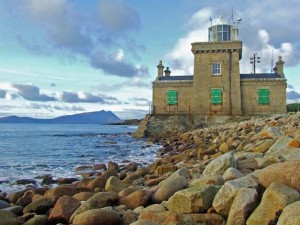Blacksod Point lighthouse, Co. Mayo
Published in Gems of Architecture, Issue 2 (March/April 2015), Volume 23
Blacksod Bay lighthouse, designed by John Swan Sloane in 1863. (John Kelly/Commissioners of Irish Lights)
The parish of Kilmore-Erris, in the north-west of County Mayo, boasts four lighthouses, three of which—Eagle Island (1836), Broadhaven or Ballyglass (1853–5) and Black Rock (1858–62)—are attributable to George Halpin Senior (1776–1854), inspector of works and lighthouses, or his son, George Halpin Junior (1804–69). Each is a whitewashed tapering tower with a lantern encircled by serpentine railings on a corbelled walkway. The fourth lighthouse, a familiar landmark at Blacksod Bay on the tip of the Mullet peninsula, was first mooted in 1841, but it was the early 1860s before recommendations were sent for approval to the Ballast Board, the Board of Trade and Trinity House, London. The elder brethren of the Ballast Board inspected the site on 9 June 1863 and decided that the ideal position for the lighthouse was adjacent to Blacksod Pier, designed by Alexander Nimmo (1783–1832). The lighthouse was then officially sanctioned by the Board of Trade and Trinity House.
The plans for the lighthouse were signed and dated 1863 by John Swan Sloane (c. 1823?–86), appointed superintendent of foremen and works for the Ballast Board the previous year. In contrast to the lofty towers made familiar by the Halpins, the Blacksod Point lighthouse adopts the form of a miniature fortress with a tapering tower, flanked on either side by parapeted end bays housing living quarters for the keeper and his family. Tudor Revival hood-mouldings over the openings enhance the ‘medieval’ pretensions of the façade. Approval for the design was obtained from the Board of Trade in October 1863 on condition that the light, designed by Sloane as a square lantern, be replaced by an octagonal light. As a compromise, the light as built retained two sides of the square lantern, with a polygonal glazed section facing seaward over Blacksod Bay.
A plot of one statute acre was leased from the Revd Sir William Palmer (1803–85), holder of extensive Mayo estates, at £1 per annum. As the proprietor of the nearby Altmore quarries, Palmer was well placed to offer the Board good-quality granite at a cost of £100. The contract for the work at a cost of £2,100 was awarded in 1864, and by the summer of 1865 the inspecting committee noted that the tower was ready for its lantern. Requests for tenders for the lantern brought two identical quotes of £340 and a draw saw Chance Brothers of Smethwick, Birmingham, emerge successful: this major company glazed the Crystal Palace and the Houses of Parliament and created ornamental windows for the White House, as well as supplying lenses, lights and machinery for lighthouses worldwide. A ‘Notice to Mariners’ in March 1866 stated that a fixed light showing red and white would be exhibited on the night of 30 June 1866. Blacksod Point lighthouse has remained in use since that date, facilitating safe entry into a treacherous harbour.
As a weather station, the lighthouse proved invaluable during World War II, supplying Britain with meteorological reports under an agreement dating back to the 1921 Treaty. Blacksod’s weather reports proved crucial to the timing of the D-Day Normandy landings. Today a plaque unveiled in 2004 commemorates the ‘D-Day Weather Forecast sent from Blacksod 4th June 1944’.
Damian Murphy is an architectural heritage officer with the NIAH. Series based on the National Inventory of Architectural Heritage’s ‘building of the month’, www.buildingsofireland.ie.
















